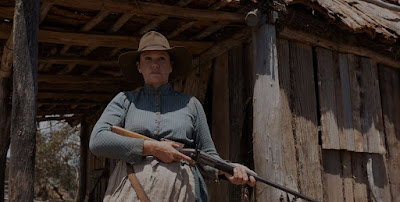In the embryonic town we see that the riff raff have started the service and entertainment economies, looking for, "a fight, a fuck and a feed" before heading home. Sergeant Klintoff has his work cut out dealing with the desk-bound trooper and problems with mishandled negotiations with first peoples which has led to, from his point of view, the crime spree of a local whose charcoaled likeness fills up a wanted poster and the driveway of Molly Johnson. Molly is ready with the rifle but her baby is even more ready to get out and about. The standoff ends with her having to accept his help. His name, his real name, not the one on the wanted poster, is Yadaka.
Leah Purcell's bold appropriation of Henry Lawson's classic bush tale is an expansion rather than an adaptation and sits comfortably beside rather than within it. Lawson's story is about ten pages long and can be read in minutes but it needs longer to digest. Within a frame of the unnamed drover's wife organising her children out of harm's way as a snake makes its way into the log cabin there is a cosmos of her experience keeping nature and the worst of humanity at gunpoint or to the extent of her physical strength. She defends the home and family against bushfires, floods, rogue animals like the one in the early scene in this film, self-entitled swaggies who demand food and more. Finally, there needs to be a showdown with the snake and the suggestion that these challenges will continue as part of her life for the rest of her life. She has made her peace with her lot, however violent it can be, and is solidly experienced to defend it.
Purcell's movie says this and more. Introducing a stronger first peoples theme, she broadens the implications of the story, giving it both a more explicit historical and political bent, while remembering to amp up the humanity of the story so that her magnetic central performance calls constant attention to her troubles, the colonial society's troubles, and the great unfeeling cosmos that rolls by mutely in the many stunning nightscapes we are treated to.
Those landscapes and sky views are essential to the telling as they go beyond establishing the high country setting to provide a blend of natural awe and strange frenetically speeded up presentations which add an alien, magical tone. The harsh colonial ethics clash with the imported European aloofness of the more established settlers and the tens of thousands of years' kinship with the land and its value in scenes that now recall revenge westerns now folklore. This is aided buy a score that blends the electric guitars of Morricone's music for Leone and a persistent Celtic yearn on the string section. And what we are left with is homage, extension and an unignorable will for story.

No comments:
Post a Comment